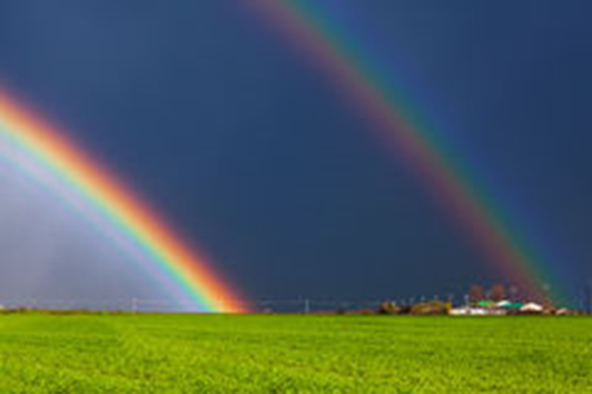Rainbow - VM - Adrie Bos
The Rainbow

A Border between Light and Darkness
by Adrie Bos
In Genesis 9 we read that God chooses the rainbow as a sign to accompany his promise that there will never be another flood – as in the time of Noah. But what is the relationship between the rainbow and the promise? Why did God choose this sign?
In order to answer this question, we have to pay attention to the context, i.e. not to the rainbow itself, but to the sky around it. The sky above the rainbow is dark, below it the sky is light. That is not a coincidence. This is caused by the sunlight that scatters the spherical raindrops not isotropically, i.e. not the same in all directions. The way the light is scattered depends on the angle by which the sunlight enters each little raindrop. From angles that are smaller than 40° white light appears and from angles that are larger than 42° no light appears. That is why we perceive the sky above the rainbow as dark and the sky below the rainbow as light.

The dark belt between the primary and secondary rainbow is called the Alexander Band. Alexander of Aphrodisias (end 2nd century after Christ) was the first to describe the band, but I don’t think he was the first to perceive the darker sky. I can imagine God saying to Noah: “Look, Noah, do you see that dark sky? That is the deluge. It is past. It is gone forever.” The rainbow shows the presence of light in the middle of darkness. Hence the rainbow is a border line between darkness and light. The rainbow separates the time before the flood from the time after the flood.
I once discussed my fascination with the rainbow with someone who responded with: “When I see the rainbow, it seems to be there just for me.” It is tempting to take this expression as purely subjective, but there actually is an objective component in it. It is a characteristic of the rainbow, independent of the person who perceives it, that the rainbow ‘looks at’ you. In other words: the perception of the rainbow is always frontal.
Imagine that you see the rainbow from within a car travelling on the highway at 60 miles per hour. You keep looking at the rainbow while the car drives past the rainbow at that speed. Will you then, after a while, see the rainbow obliquely? No. That is because the rainbow is an image. It is not a bridge, not a real physical object around or over which you can walk, but an image that moves with you, just as your mirror image moves with you if you shift your head. The rainbow thus continues to look at you, when you move yourself.
This characteristic has a surprising consequence. Imagine a scene where a number of people are looking at the rainbow, while they are not standing close together. All those people are perceiving the rainbow frontally. How can that apply to all these people at the same time? That is possible when you realise that all these people are not looking at the same rainbow. Each spectator sees his or her own rainbow. Only when your eye is in the same position as that of your neighbour are you looking at the same rainbow. That is what makes the perception of the rainbow uniquely personal.
Could it be that this has a more profound meaning? Just as each person perceives their own rainbow, so also is the promise of the rainbow valid for each of us. On the one hand the rainbow is a phenomenon that connects heaven and earth and the account of its origin in Genesis 9 deals with matters of global significance. But at the same time it is a phenomenon that is perceived in a most personal way. It is a promise for the whole world but also for each of us personally.
*******
Until his retirement, Adrie Bos (b. 1949) was a university lecturer at the Technical University in Delft. He researched the occurrences of light in solid matters under the influence of radiation.
ArtWay Visual Meditation 29 December 2019


